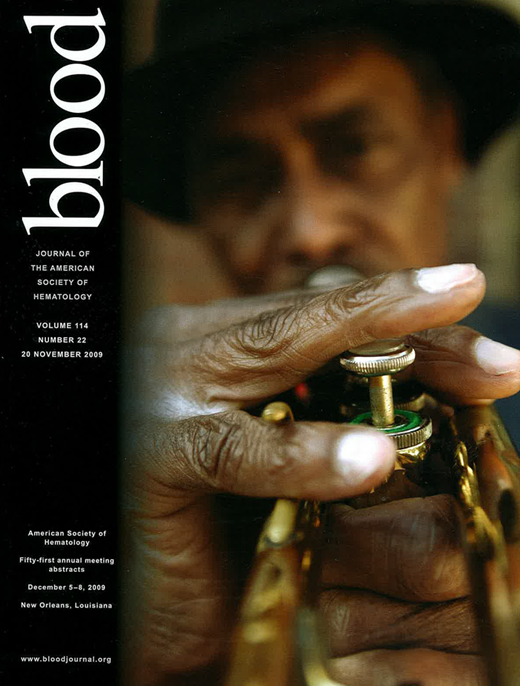Abstract
Abstract 1389
Poster Board I-411
Although lamivudine (LMV) prophylaxis is recommended for chronic hepatitis B (HBV) patients undergoing cytotoxic chemotherapy for their malignant disease, viral reactivation sometimes occurs during or after LMV administration. Patients with solid tumors and hematologic malignancies may have different risk of HBV reactivation because hematologic malignancies require more intensive and immunosuppressive treatment. The aims of this study are to determine predictors of LMV prophylaxis failure and to evaluate the relative risk of failure in patients with hematologic malignancies.
Cancer patients were routinely screened about serum hepatitis B surface antigen (HBsAg) before the initiations of chemotherapy. HBsAg-positive patients received LMV prophylaxis (100mg/day po) during the chemotherapy and for 1 to 6 months after the completion of chemotherapy. Serum HBV titer and alanine aminotransferase (ALT) level were followed at least every 3 months. Viral breakthrough during chemotherapy was defined as 10-fold or more elevation in serum HBV DNA titer above nadir regardless of serum ALT. Withdrawal hepatitis was defined as an increase of serum ALT more than upper normal limit accompanied by an elevation in serum HBV DNA titer more than that of the pre-exacerbation baseline. Either of viral breakthrough or withdrawal hepatitis was regarded as prophylaxis failure. Time to viral breakthrough was measured from the start of LMV, whereas time to withdrawal hepatitis was measured from the discontinuation of LMV. Time to prophylaxis failure was measured from the LMV initiation to either of viral breakthrough or withdrawal hepatitis. Kaplan-Meier method was used to generate survival curves of each event and log-rank test was employed to compare them. Patients were censored at death without viral reactivation or last follow-up. Cox proportional model was used to estimate the relative hazards ratio of each event in various subgroups. Death without HBV reactivation was regarded as a competing risk event and Fine and Gray model was used to adjust it.
One hundred eleven patients were enrolled and 28 patients had hematologic malignancies (non-Hodgkin lymphoma: 20, acute leukemia: 8). Remaining 83 patients had solid tumors such as gastric cancer, colorectal cancer, and lung cancer. Median follow-up duration was 22 (range 1.2-83.6) months and 30 patients experienced the prophylaxis failure (viral breakthrough: 15, withdrawal hepatitis: 15 patients). Log-rank test showed that liver cirrhosis, rituximab treatment, high serum HBV DNA titer (°Ã20,000 IU/ml), and hematologic malignancies were significant predictors (p <0.05), so that Cox proportional model was constructed using them. This model satisfied the assumption of proportional hazards and didn't constitute the mulicolinearity. In these models, high serum HBV DNA titer and hematologic malignancies were significant predictors of prophylaxis failure. High serum HBV DNA titer was also a significant predictor of viral breakthrough and hematologic malignancies were marginally significant. However, only high serum HBV DNA titer remained significant after Fine and Gray adjustment of a competing risk factor. Liver cirrhosis and high serum HBV DNA titer were significant predictors of withdrawal hepatitis. The model of withdrawal hepatitis didn't require Fine and Gray adjustment, because there was no death without viral reactivation after the discontinuation of LMV.
Patients with hematologic malignancies or high serum HBV DNA titer are at greater risk of prophylaxis failure and need more intensive anti-viral prophylaxis.
| . | Prophylaxis failure . | Viral breakthrough . | Withdrawal hepatitis . | |||||||
|---|---|---|---|---|---|---|---|---|---|---|
| Cox model . | Fine and Gray . | Cox model . | Fine and Gray . | Cox model . | ||||||
| HR . | p-value . | HR . | p-value . | HR . | p-value . | HR . | p-value . | HR . | p-value . | |
| Liver cirrhosis | 1.193 | 0.72 | 1.132 | 0.76 | 0.722 | 0.630 | 0.692 | 0.54 | 7.39 | 0.0026 |
| Rituximab | 0.700 | 0.62 | 2.086 | 0.35 | 0.824 | 0.840 | 1.895 | 0.43 | 2.32 | 0.42 |
| High serum HBV DNA titer | 15.671 | <0.0001 | 8.119 | 0.0001 | 14.179 | 0.003 | 5.509 | 0.018 | 7.16 | 0.0012 |
| Hematologic malignancies | 4.554 | 0.014 | 1.425 | 0.61 | 4.659 | 0.055 | 1.840 | 0.41 | 0.89 | 0.89 |
| . | Prophylaxis failure . | Viral breakthrough . | Withdrawal hepatitis . | |||||||
|---|---|---|---|---|---|---|---|---|---|---|
| Cox model . | Fine and Gray . | Cox model . | Fine and Gray . | Cox model . | ||||||
| HR . | p-value . | HR . | p-value . | HR . | p-value . | HR . | p-value . | HR . | p-value . | |
| Liver cirrhosis | 1.193 | 0.72 | 1.132 | 0.76 | 0.722 | 0.630 | 0.692 | 0.54 | 7.39 | 0.0026 |
| Rituximab | 0.700 | 0.62 | 2.086 | 0.35 | 0.824 | 0.840 | 1.895 | 0.43 | 2.32 | 0.42 |
| High serum HBV DNA titer | 15.671 | <0.0001 | 8.119 | 0.0001 | 14.179 | 0.003 | 5.509 | 0.018 | 7.16 | 0.0012 |
| Hematologic malignancies | 4.554 | 0.014 | 1.425 | 0.61 | 4.659 | 0.055 | 1.840 | 0.41 | 0.89 | 0.89 |
No relevant conflicts of interest to declare.
Author notes
Asterisk with author names denotes non-ASH members.

